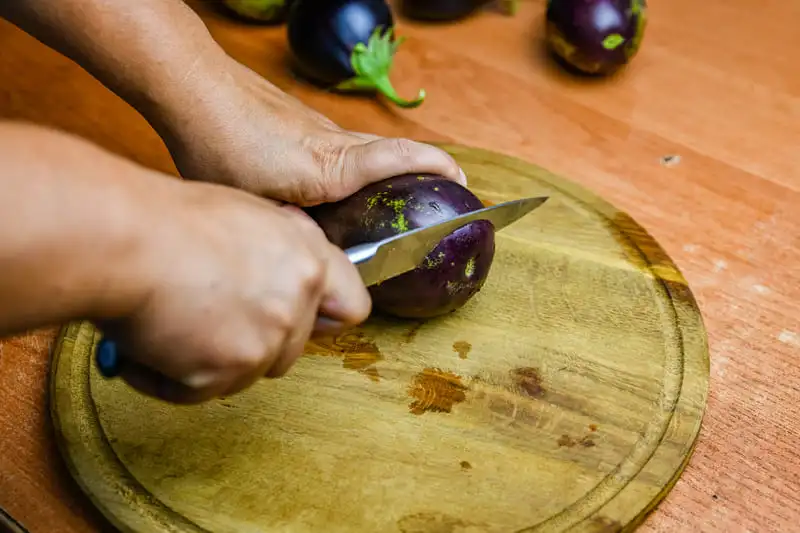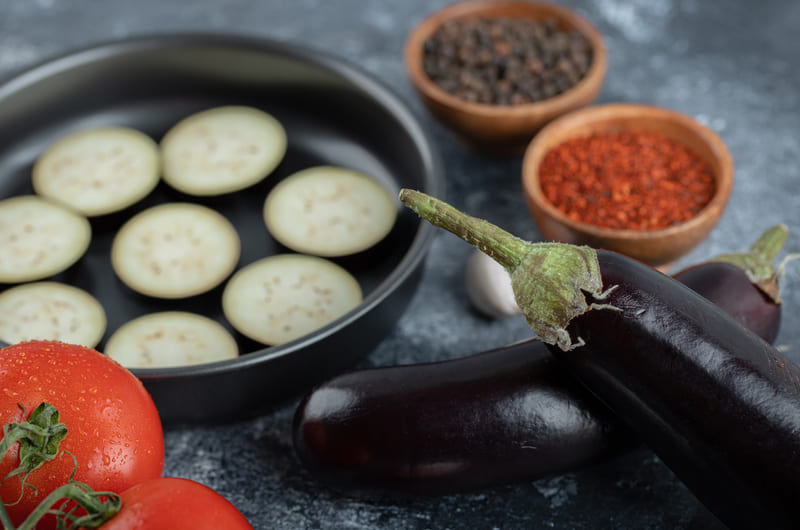Should you peel eggplant for eggplant parmesan? is one of the most debated questions is whether or not to peel the eggplant. The decision often depends on factors like the size of the eggplant, personal taste preferences, and the desired texture of the dish.
While some cooks swear by leaving the skin on, others prefer a smoother, peel-free bite. Let’s explore when you should peel eggplant and when you might want to leave it as is.
Why Eggplant Skin Matters
Eggplant skin plays a significant role in the taste, texture, and appearance of the dish. The skin of smaller eggplants is generally tender and mild, while larger eggplants tend to have thicker and slightly bitter skin.
Whether you choose to peel or not often depends on your recipe and the type of eggplant you’re using.
For baked dishes like eggplant parmesan, the skin can sometimes become chewy or tough. According to The Stay At Home Chef’s guide to eggplant parmesan, peeling is recommended for larger eggplants to ensure a smooth texture, but it is entirely optional for smaller varieties.
Additionally, leaving the skin on adds fiber and nutrients to the dish, making it a healthier option for those who don’t mind a bit of texture. Learn more about the best way to prepare your eggplant in this AllRecipes guide, which also explores salting techniques.
If you’re looking for a vegan spin on this dish, try Vegan Eggplant Parmesan: A Wholesome and Delicious Twist for a plant-based recipe that balances texture and flavor beautifully.
To Peel or Not to Peel: Factors to Consider for Eggplant Parmesan
When preparing eggplant parmesan, deciding whether to peel the eggplant is a matter of personal preference and the type of dish you want to create. Understanding when and why to peel (or not) can help you achieve the ideal texture, flavor, and nutritional balance.
When to Peel Eggplant

Large or Mature Eggplants
The skin on larger or more mature eggplants tends to be thicker and tougher, often contributing a bitter taste to the dish. Removing the skin in these cases ensures a smoother, more enjoyable bite. Peeling is especially recommended if your recipe focuses on a creamy consistency, such as in pureed sauces or layered casseroles.
Texture Preferences
For those who enjoy a silky texture in their eggplant parmesan, peeling the skin is an excellent choice. Without the fibrous outer layer, the eggplant absorbs sauces more readily, enhancing its creaminess and melding flavors seamlessly.
Sensitive Palates
If you’re cooking for diners who prefer milder flavors or dislike even a hint of bitterness, peeling is a safe option. Removing the skin eliminates potential tough or bitter elements that might detract from the dish.
For additional tips on preparing eggplant for breading and frying, explore What is a Substitute for Eggs in Breading Eggplant?.
When to Leave the Skin On
Small or Young Eggplants
Younger eggplants have thin, tender skin that softens beautifully during cooking. Leaving the skin on adds a slight crunch, which can provide a pleasant textural contrast in dishes like baked or fried eggplant slices.
The thinner skin also blends seamlessly into layered recipes like eggplant parmesan.
Added Nutrients
The skin of an eggplant is rich in fiber and antioxidants, including nasunin, which supports brain health by reducing oxidative stress. Keeping the skin intact boosts the nutritional profile of the dish while contributing to a more satisfying meal.
Visual Appeal
Retaining the vibrant purple color of the skin adds a striking visual element to the dish. The contrast between the dark skin, golden breadcrumbs, and bright tomato sauce makes eggplant parmesan not only delicious but also visually stunning.
For more ideas on incorporating nutrient-rich ingredients into your meals, check out Does Lentil Soup Burn Belly Fat?.
Balancing Preferences and Practicality

Whether to peel or not often comes down to the size and maturity of the eggplant as well as the preferences of those enjoying the dish. You might choose to peel some slices while leaving the skin on others to satisfy a range of tastes and textures in the same recipe.
For tips on creating perfectly breaded eggplant slices with or without the skin, visit Do I Need to Rinse Lentils Before Making Soup?.
Preparing Eggplant for Parmesan: Steps for Success
Achieving perfectly cooked and flavorful eggplant parmesan starts with proper preparation. From cutting the eggplant to salting it for optimal taste, these steps ensure your dish is as delicious as possible.
Cutting the Eggplant
Uniform slicing is essential for even cooking and a consistent texture. Depending on your preferred presentation or recipe style, consider these cutting options:
- Rounds for Traditional Layering: Cutting the eggplant into ½-inch thick rounds is ideal for classic eggplant parmesan. This shape allows for easy stacking with tomato sauce and vegan cheese in a baking dish, creating the traditional layered look.
- Lengthwise for a Creative Twist: Slicing the eggplant lengthwise offers a unique presentation and is particularly effective for rolled or stacked variations of the dish. This method also works well if you want larger slices that cover more surface area in each layer.
For expert techniques on cutting eggplant effectively, explore Do I Need to Rinse Lentils Before Making Soup? for additional preparation tips.
Salting the Eggplant
Salting is a classic method used to draw out excess moisture and reduce the natural bitterness found in larger or mature eggplants. This step is particularly helpful if you’re using older eggplants with tougher skins or a slightly bitter taste.
Steps for Salting:
- Arrange the eggplant slices on a flat surface, such as a baking sheet lined with paper towels.
- Sprinkle salt evenly over the slices, ensuring both sides are lightly coated.
- Let the slices sit for 20–30 minutes. The salt will draw out water from the eggplant, which helps remove bitterness and improves texture.
- Rinse the slices under cold water to remove excess salt, then pat them dry with a clean kitchen towel.
Salting enhances the eggplant’s natural flavor while creating a firmer texture that holds up well during breading and baking. It’s effective whether the eggplant is peeled or not, making it a versatile step in preparation. For more information on salting methods, visit What is a Substitute for Eggs in Breading Eggplant?.
Why Preparation Matters
Taking the time to cut and salt your eggplant properly ensures your final dish is tender, flavorful, and free of any bitterness.
Whether you’re layering traditional rounds or opting for a more creative presentation, these preparation steps provide a solid foundation for making exceptional vegan eggplant parmesan.
For more guidance on creating plant-based comfort foods, explore Does Lentil Soup Burn Belly Fat? to discover additional culinary techniques.
Cooking Methods and Their Effects on Eggplant Skin
The cooking method you choose for preparing eggplant plays a significant role in determining whether to leave the skin on or peel it. Each method affects the texture, flavor, and overall presentation of the dish, particularly when working with small versus large eggplants.
Baking
Baking is a popular and straightforward method for preparing eggplant parmesan.
- Skin Texture: During baking, the skin softens, blending well with the tender flesh of small or young eggplants. The gentle heat ensures that the skin becomes less fibrous, making it pleasant to eat while retaining its nutrients.
- Best Practices: To achieve even cooking, arrange eggplant slices in a single layer on a parchment-lined baking sheet. Brush lightly with olive oil for enhanced flavor and a touch of crispness. Baking at 375°F (190°C) is ideal for softening the skin without overcooking.
- Presentation: The vibrant purple skin of small eggplants adds a visually appealing contrast to baked dishes, enhancing the overall aesthetic.
For another recipe that uses baking to create delicious results, check out The Ultimate Guide to Making 5-Ingredient Banana Bread.
Frying
Frying is a traditional method that delivers rich, crispy eggplant slices.
- Skin Texture: Peeling is often recommended when frying because the skin can remain tough and interfere with the crispiness of the breading. Without the skin, the breading adheres more uniformly, ensuring a golden and crunchy exterior.
- Best Practices: Dip peeled eggplant slices into an egg substitute (like aquafaba or flaxseed gel) before breading with seasoned breadcrumbs. Fry in a neutral oil such as canola or sunflower oil for the best results.
- Nutritional Considerations: While frying adds flavor, it also increases calorie content. To reduce oil absorption, drain fried slices on paper towels immediately after cooking.
For tips on effective breading techniques, visit What is a Substitute for Eggs in Breading Eggplant?.
Air-Frying
Air-frying is an excellent alternative to traditional frying, providing a healthier option without sacrificing texture.
- Skin Texture: The circulating heat in an air fryer creates a slightly crunchy texture, making it an ideal method for preparing skin-on eggplant. The skin crisps up nicely while the flesh becomes tender, offering a satisfying contrast in each bite.
- Best Practices: Preheat the air fryer to 375°F (190°C) and arrange slices in a single layer. Lightly coat with oil or cooking spray to promote even browning. Flip the slices halfway through for uniform crispiness.
- Health Benefits: Air-frying uses significantly less oil than traditional frying, preserving the nutritional benefits of the eggplant while reducing overall fat content.
For more ideas on using air-frying to create crispy, flavorful dishes, explore Does Lentil Soup Burn Belly Fat?.
FAQs
If you’re unsure about whether to peel eggplant when making eggplant parmesan, these common questions can help guide your preparation process. Knowing when and why to peel can make all the difference in achieving the perfect dish.
Do you leave the skin on for eggplant parmesan?
For smaller eggplants, the skin is tender and cooks down beautifully, adding a slight crunch and visual appeal to the dish. Leaving the skin on also retains valuable nutrients like fiber and antioxidants. However, for larger eggplants, the skin can be tough and bitter, so peeling is often preferred for a smoother texture.
For tips on how cooking methods affect the skin, check out Cooking Methods and Their Effects on Skin.
Is it better to peel eggplant before cooking?
Peeling is recommended for recipes where a soft, creamy texture is desired, such as purees, layered casseroles, or dips like baba ghanoush. However, in dishes like baked eggplant parmesan, whether to peel depends on personal preference and the size of the eggplant. For more insights into preparing eggplant for different cooking methods, visit Preparing Eggplant for Parmesan.
What is the best way to cut eggplant for eggplant parmesan?
Uniform slicing ensures even cooking. For traditional eggplant parmesan, slicing into ½-inch thick rounds works well for stacking and layering. For a creative twist, cutting the eggplant lengthwise offers larger slices that are perfect for rolled or stacked presentations. Learn more about cutting techniques and their effects in Techniques for Perfect Breading Without Eggs.
Do you need to salt eggplant before making eggplant parmesan?
Salting is not always necessary but is highly recommended for reducing bitterness and removing excess moisture, particularly in large eggplants. Salting also helps the eggplant maintain its shape during cooking, making it ideal for baked or fried preparations. For step-by-step instructions, read Salting Eggplant for Better Results.
Does peeling eggplant reduce bitterness?
Yes, peeling removes most of the bitterness that can be concentrated in the skin of larger or more mature eggplants. For younger eggplants, the skin is less bitter and often doesn’t need to be removed. To decide whether to peel based on your recipe, explore To Peel or Not to Peel: Factors to Consider.
Conclusion
The question of whether to peel eggplant for eggplant parmesan ultimately comes down to the size of the eggplant, the desired texture, and personal taste preferences. Peeling large, mature eggplants can make the dish smoother and more enjoyable for those sensitive to bitterness, while leaving the skin on smaller eggplants provides added nutrients and a unique texture. Experiment with both methods to find your perfect balance of taste and texture.
For additional tips on preparing eggplant dishes, explore Vegan Eggplant Parmesan: A Wholesome and Delicious Twist and What is a Substitute for Eggs in Breading Eggplant? for related recipes and techniques.

